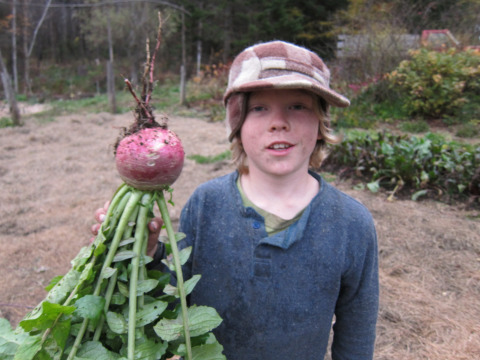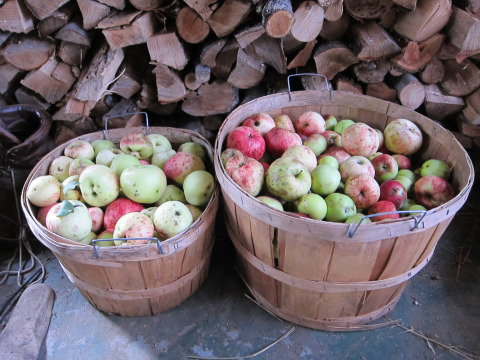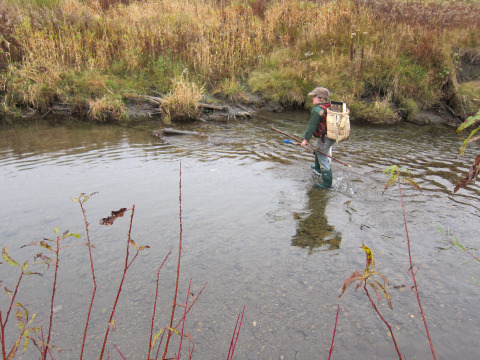Ben Hewitt's Blog, page 59
November 12, 2013
The Greater Luxury
Almost forgot: I’ll be at my hometown library tonight @ 7 for a reading and discussion. Ya’ll should come on down. Afterwards, we’ll go out to… actually, forget it. There’s nowhere to go out to. But we’ll have us a grand ole time, anyhow.
I am in the final stages of completing the first draft of my upcoming book on unschooling. Actually, it’s about a lot more than unschooling, because the way our children learn cannot be separated from the way we live, or from where we live. So the book is also about how and where we live and how we got here, and about how all these things inform the ecosystem of Fin and Rye’s learning. And not just of Fin and Rye’s learning, but also how Penny and I learn. And not just how we learn, but also how we unlearn, because the humbling truth is that we’ve probably had to unlearn more than we’ve had to learn. Maybe by the time we die, we’ll finally have unlearned everything there is to unlearn. Maybe that’s when we’ll really start learning. Hey, better late than never, eh?
A few folks have asked how I juggle my paying (writing) work and farm/family duties. To be honest, time management’s never been too much of an issue for me. There’s simply too much stuff I want to be doing away from my desk to make frittering away my office time an attractive option. Certainly, some days are more productive than others, but I’ve learned to recognize when I’m banging my poor, soft melon against the wall (because, you know, it hurts). On those days, it’s almost always more productive in the long haul if I just walk away. That’s one of the great luxuries of working for one’s self, and also of having other work that feels important to me. If the words ain’t flowing, there is always firewood or milling or tinkering with the tractor or scratching the pigs behind the ears or whatever.
I generally ride the desk from about 7:30 to noon, and maybe again from about 1:00 to 2:30 or so. At least one day per workweek, I cut the writing short, which means I’ll be at my desk from 7:30 to 10 or so, and then again in the late afternoon for maybe a half-hour, attending to email and whatnot. My office schedule also shifts according to season and deadlines, with summer being devoted primarily to the land and animals.
Having said all this, I should note that it’s becoming increasing difficult for me to distinguish between the varying aspects of my life. Writing, farm, family, teaching, work, learning, leisure, unlearning, and play: The older I get, the more connected they all become, with one informing the other, often in ways that are only revealed through the lens of perspective that requires months, if not years, to ripen.
To be sure, there is a tangible physical divide between what I do to earn my living and what I do to simply live, and for that I am by turns grateful and bemoaning. I love physical labor and I know how much my mind and body crave it. But I also know that as I grow even older and feebler of muscle and flesh (goodness, is such a thing is even possible?), I might well be glad that my income is not entirely dependent on my too-frail body.
I am enormously grateful that my life has evolved to a place where it’s hard to distinguish between what is work and what is not, what is family time and what is not, what is time for learning and what is not, what is leisure and what is not. I know the compartmentalization of these things works for some people; I know that some folks revel in leaving work at work and home at home. I do not have this luxury. But for me, at least, the greater luxury is living as if the boundaries between these things didn’t exist in the first place.

November 11, 2013
Nothing Irrelevant About That
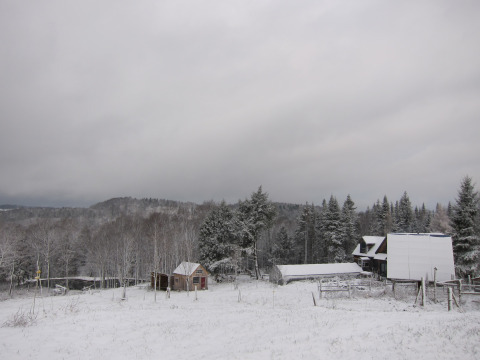
First sticking snow
On Saturday, after we’d finished chores, after I accompanied the boys on the daily running of their trapline, after we’d jarred another batch of kimchi, after we’d dispatched the last of the season’s lambs, and after I’d unsuccessfully attempted to resuscitate the truck, which had died a sputtering death in town the previous evening, I lit out for the north, in order to retrieve a half hog we’d taken to the butcher. The pig was destined for a friend’s table, and as such, we’d deemed it wise to hire a professional to cut and wrap the beast. Not everyone so willingly tolerates the eyesore roasts and chops we turn out atop our kitchen table.
Anyway, there I was at 5 o’clock-ish, motoring back from the butcher loaded with boxes of piggy parts, just starting to sink irretrievably into the sweet fatigue of a day spent in productive motion, when I came upon the cluster of cars at the road’s edge. There was a big black Lexus SUV amongst them, bits of plastic protruding from beneath the driver’s side wheel well. And at the opposite side of the road, to what did my wondering eyes appear? Why, a young fella dragging the corpse of a deer into the ditch. Even from a distance I could see that the deer (a doe, as it turned out), was in fine flesh and not too badly damaged. I mean, other than being dead, of course.
“You got any plans for that,” I inquired, after I’d halted the Subie and stepped onto the shoulder. Clearly he didn’t; he was dragging the poor beast into the ditch to rot, after all. But it seemed only polite to ask. With the assistance of the Lexus driver, who was clad in designer jeans and obviously uncomfortable at the thought of handling a dead deer (“I’ve never done anything like this,” he said. “She’s so… floppy”), I got the girl loaded into the back of the car, snuggled against the boxes of frozen hog bits.
Long story short, my new friend and I arrived home at 6, whereby I strung her up and by the lights of the tractor, liberated hide and organs. On Sunday, Penny proceeded to flesh the hide in preparation for tanning, whilst I laid the chilled carcass atop the counter and commenced to cutting and wrapping.
That’s the story. Here’s the moral, as I see it, although perhaps it’s not so much a moral as a reflection on my own curious assemblage of skills and capacities and how there was something about the procurement of that deer and the simple fact that I was able to make something of it that confirmed the strange, serpentine path of my life.
It’s a discomfiting thing, sometimes, inhabiting a world in which it often seems as if the small body of knowledge and experience contained within the vessel of my body and mind is irrelevant. Or nearly so, anyway. I know this isn’t really true; I realize the things I know and know how to do aren’t really irrelevant. But it’s also true that many of these things – most of them, probably – aren’t terribly marketable. They’re rarely acknowledged. They bring little recognition or acclaim, and as such, it can occasionally seem as if they don’t much matter.
What’s more, even what I do know – how to build a house or barn, or slaughter a hog, or make kimchi, or fell a tree, or whatever – I know less well that those who specialize in these tasks. I suppose writing is as close as I come to a specialty, unless one considers my very generalism a specialty (hmm… now there’s an interesting thought). In some regards, it’s sort of ironic: As I’ve come to know more and more about how to survive and thrive on this piece of land and in this community, I’ve become even more of a generalist. And the time passed accruing that knowledge and experience is time that hasn’t been passed developing the skills that would garner the recognition necessary to lend them marketability and perhaps imbue them with a sense of their being relevant.
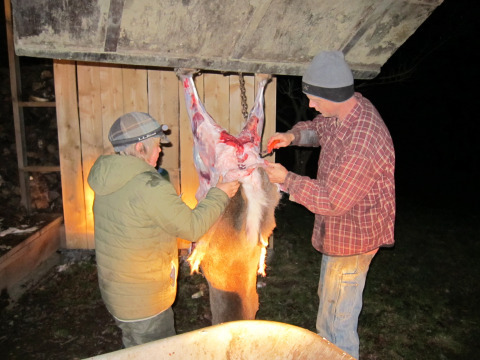
Thank you, deer
Yet here I am, with a nice, fat doe in the freezer simply because when I happened upon that unfortunate scene, I didn’t have to think about it for even an instant. I saw that deer being dragged into ditch and I conjured an image of exactly how the rest of my evening was going to unfold, the animal hanging from the tractor bucket, a pot of hot water and two sharp knives at my side, my sons crowding in and clamoring to help, my feet going cold in the thin skim of snow that hadn’t quite melted. I knew that Penny would be happy for the hide and the boys for the strong lengths of sinew along the doe’s back. I knew the meat would feed my family and friends.
As surely as my hands still carried the faint smells of kimchi, diesel, and fresh-killed lamb – my day in odors – I knew that the experience contained within the vessel of my body and mind would keep that doe from bloating and rotting in the ditch. And there was nothing irrelevant about that.

November 8, 2013
Needed
The boys have grown up in the gardens. Before they could walk, we propped them up in a sandbox we’d built at the edge of what was then our primary garden plot, and they’d dig and gnaw sand and generally caper about while Penny and I (but mostly Penny) seeded and weeded and whatnot.
By the time both boys were four, they had their own rows in the garden. We still have the signs they painted to mark their territory. Garden of Fin, reads one, though you have to tilt your head to make it out. The other, crafted after Rye had arrived on the scene, but before the boys understood the grammatical rules of possession, reads Fin and Rye Garden.
In allowing them such free access to our gardens, we had to let go of a lot. Or really, Penny had to let go of a lot. She’s always been the primarily green thumb around the parts. Oh sure, I’ll do what’s asked of me on the vegetable front, but truth be told, I’m a cow and pig man, and not-totally-useless when it comes to the operation of the mechanical contraptions that enable so much of what we do. Tractor. Chainsaw. Sawmill. And so on.
Anyway. Back to letting go. What I mean is that we made a conscious decision early in the boys’ lives to sacrifice a degree of order and convenience so that they might participate in the day-to-day operations of our humble holding. Some of this letting go was accepting the inevitable mistakes and messes that result from their learning – the row of fledgling beets they pulled, thinking they were “weeds,” or the folded over nails in the cow shed siding from their early hammering efforts – and some of it was simply letting go of our expectations regarding how long a particular task might take. Truth is, it takes a hell of a lot of patience to include young children in productive work, and it requires humbling yourself to the reality that it ain’t going to be as productive as you’d like. Except of course it is, because some of what you’re producing is a child with confidence and skills and resourcefulness. But you gotta take a pretty long view to see those things, and I don’t think humans are particularly good at taking long views. At least, not in this day-and-age.
Sometimes, I think there’s a misperception that unschooling parents don’t do much. That they just let their kids run willy-nilly whilst the adults go about their days. In this family, at least, nothing could be further from the truth. In this family, unschooling is not easy, or convenient. It demands significant reservoirs of thought and patience and, as I’ve pointed out, presence. I don’t think parents are all that accustomed to being patient and present for their kids anymore, at least if what I observe when I venture out into the so-called real world is any indication. And really, who the hell has the time or energy for it all? You work 40, 50, 60 hours a week, you come home exhausted, and all you really want to do is crack open a cold one and sidle up to the idiot box while your kids do whatever it is your kids are doing. Well, that’s what I’d want to do under such circumstances, anyway. 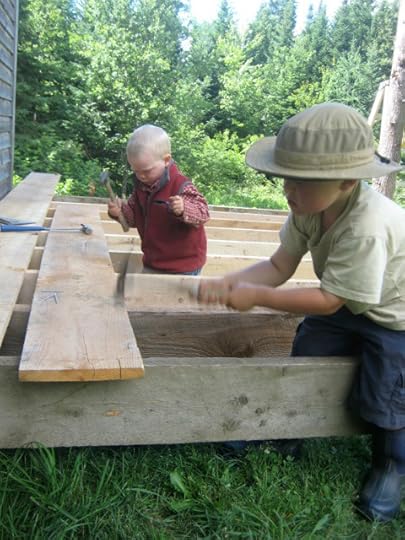
For us, owing to the fairly unique particulars of our lives, the presence hasn’t been as hard as the letting go. Penny and I have always been bull-and-jam doers. Put simply, we like gittin’ shit done, and incorporating small children into the process all but ensures that less shit will git done. There’s just no way around it.
I still get impatient from time-to-time, but not very often. Part of this is because I have genuinely become more patient over the years. It’s a slow and never-finished process, not unlike developing gratitude or generosity. The other part is that the boys have actually evolved into legitimately productive contributors to home and farm. They don’t pull up beets by mistake. They don’t bend nails, anymore. Or no more than I do, anyway.
It has always bothered me to see how some parents chase their children away from productive jobs. I have seen it many times, and while I understand the impulse, I have little empathy for the shortsightedness of it, because the truth is that long before they are capable of truly helping, kids desperately want to contribute.
Like all of us, children just want to be needed. It’s our job to make sure they actually are.

November 7, 2013
Never Learned Ya’ Nothing

Back in August…
We got the garlic planted this past weekend. We used to plant in mid-October – Penny remembers planting the day before Rye’s birth, on October 14, 2004, crawling along the rows, bent over her eight-month and 30-day belly - but this whole climate change debacle has pushed our planting date to November 1 or thereabouts. By the by, when I say “we” and “our”, I actually mean Penny and the boys, each of whom has their own plot to sow and tend. Garlic has been a profitable crop for the fellas; this year, they traded away multiple pounds, primarily with Nate, possessor of innumerable esoteric wildcraft tools of the sort my sons covet. A couple weeks back, Rye was considering whether or not to agree to a particularly juicy trade for the last of his stash. “I can’t do it,” he said to Penny, almost mournfully. “I have to keep my seed stock.” Attaboy.

Da boyz, putting money in the bank
The thing I love about garlic (other than the obvious) is the profound demonstration of faith it demands. I mean, really: Planting in November, on the honed knife’s edge of autumn? It’s amazing enough to plant something in April and see it thrive, but to plant something on a day of the season’s first drifting snow, clawing through the thin crust of frost to the cool soil below… well, If that ain’t proof that humans are but a minority piece of all the magic in this world, I don’t know what is.

Next year’s crop. Or a fraction thereof, anyhow
More pragmatically, garlic is convenient because its cycle is so perfectly juxtaposed to pretty much every other living thing on this humble farm. You plant in November, after the last of the crops have been gleaned from the field and tucked into their respective places of winter storage: The root cellar, the cool, dry storage room that was once a sort-of bathroom, the basement, the freezer, the pantry. And you harvest in August, during the short, sweet summer lull between first cut haying and the pinnacle of late summer’s bounty. Furthermore, once you have your crop established, there is never any need to purchase inputs. Garlic is the easiest of all seed to save – just don’t eat or trade the last of your haul and you’re golden.
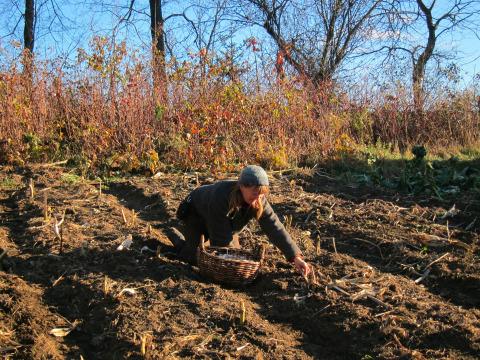
A rare sighting of the species known as the Crafty Penny in her favored habitat
Here’s another great thing about garlic, a trick I learned from Penny. Ok, so another trick I learned from Penny (she being teacher of almost all my tricks). The in-soil remnants of the prior year’s crop – the few random bulbs or dislodged cloves that were missed during harvest – are a powerful pest deterrent, particularly for brassicas. So every year, my crafty wife plants the broccoli in the space that was allotted to last year’s garlic and it grows hale and hearty, free of all the small crawlers that might otherwise plague it.
Don’t say I never learned ya’ nothing.

November 4, 2013
Rubbing Against Elegance
Warning: Photos of white-trash food processing to follow. Proceed with caution!
As I write, the boys are preparing a pan of batter-fried muskrat, and Penny is wrapping the fatty fruits of our latest home brew bacon. I do appreciate our sons’ commitment to using the whole animal, but fried muskrat? When there’s something like 50-pounds of just-off-the-slicer bacon under my nose? Those poor boys are bringing a knife to a gun fight…

Pig, fire, pit. Happiness
We’ve been making bacon for a decade or so, which is to say, since before bacon went and got its hipster on (what’s with that, anyway? All of sudden bacon’s cool? All of a sudden folks feel compelled to sport “I HEART bacon” tee shirts and bumper stickers? Well, of course you love bacon, ya goob. It’s friggin’ bacon!). Over the years, we’ve refined our technique and, almost in spite of our bumbling selves, now make a consistently excellent product, if I do say so myself. Which I just did.
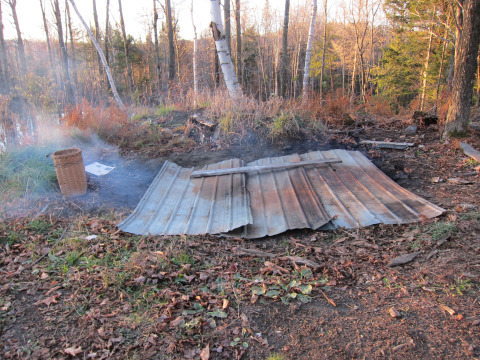
Smoking bacon. A little rough on the lungs, sure, but man, oh, man, the buzz!
It’s pretty simple, really. We cover the slabs with water, keeping track of how much water we use, so we can add a cup of salt per gallon. We add a 1/2 cup of maple syrup to each bucket, and put it somewhere cool for a week or so. It’s wicked important that it stays below 40-degrees, or you run the risk of things going funky. I generally stick the brine buckets in the basement (ambient temp around 55) and add ice to the water each day to keep the brine temp low enough.

Slab after smoking
After a week of submersion, we smoke the slabs in what is perhaps best described as a hole in the ground covered with old roofing tin, since that’s exactly what it is. I give ‘em about 12 hours of smoke, then leave them overnight to cool and stiffen for slicing; last night was perfect, since the temp got down to 15 or so, and bacon slices best when it’s right on the edge of frozen.

I found this slicer on Craigslist for $200. Wicked deal
By-the-by, on the off chance that any of ya’ll are inspired to try this your-own-bad-selves, be sure to find tin that’s lost at least the majority of its galvanized coating to rust or fire. I don’t know exactly what’s in that stuff, but I’ve got a sneaking suspicion you don’t want it anywhere near yer breakfast. Much less in the air you’re breathing.
What can I say? I love making bacon. It is one of those rituals I have written of before, like firewood or haying, connected to a particular season and process that I have come to know so well I can hardly imagine what our lives were like before it was a part of our lives. I realize how absurd that might sound, and of course it’s not about making bacon, specifically. Rather, it’s about everything that making bacon is imbued with: The embrace of process and practice. The rejection of convenience’s flawed logic. The quiet satisfaction of responsibilities accepted, of intent understood and acted upon.
Making bacon is one of those tasks that allows me to forget, for a while anyway, everything that is broken or breaking in this amazing, beautiful world. It is so unpretentiously elegant in its simplicity – meat, fire, smoke – and I cannot help but feel as if I am in some crude way rubbing up against that elegance. I think there is something to be learned from that soft contact, and I’m pretty sure it has to do with how I wish to be in this world. And damned if I won’t take as much of that feeling as I can get.

October 31, 2013
Easy as Pie
Someone was asking in the comments the other day for our applesauce recipe and that, coupled with the fact that we just finished putting up the last of the season’s apple-y concoctions, prompted this post.
First off, I’ll say that we don’t often buy apples. We have in the past, and we may in the future, but generally we get by with what our handful of fairly young trees produce and whatever we can glean off the wild trees in the neighborhood. This was one of the best apple years in recent memory (which in my case means in any memory at all); Melvin says that means it’s going to be a hard winter, and I hope like heck he’s right. All the wild trees around us were loaded, and we didn’t have to travel more than a quarter-mile to get all we needed. Our general technique is to spread a tarp on the ground, hoist Penny or myself into the tree, crawl out onto the most prolific branches and start shaking the bejeezum out of it. Instant apple rain.
For all the apples we pick (shake?), we don’t actually eat that much of the bare fruit. Oh, sure, the boys’ll stuff their faces for a few days, until their bellies go on strike, but for the most part, our apples are processed into one of three products: Applesauce, fruit leather, or dried loops.
The asked-for recipe is both really freakin’ simple and also sort of hard to explain. That’s because it’s pretty much never the same thing twice, and how we make our sauce depends on all sorts of things, such as what we have on hand, what else we’ve got going on, and whether or not it’s the sort of day we’d rather spend doing something else. If we’re in a hurry, it looks like this:
Quarter apples and throw ‘em – peels, cores, and all – into 5 gallon pot with 3 cups of water so apples don’t stick
Simmer until soft, and run through food mill
Add cinnamon, nutmeg, and maple syrup to taste
Process in steam canner
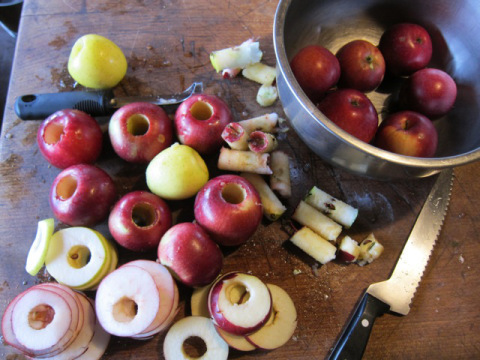
Coring and slicing for dried rings
If it’s a rainy day, and we’re not chomping to get out into the world beyond our windows, we make it the way we really like it:
Peel and core (we use a device that looks like this minus the ridiculous apple shape)
Chop whatever size you want for chunky sauce
Simmer with water as above
Add cinnamon, nutmeg, and maple syrup to taste
Process in steam canner
We also make a version with peels by simply coring and putting the cored apples in the food processor with just enough water to make it blend smooth. We then cook to the consistency we want. There is probably some nutritional benefit from including the peels, which may explain why I grew 4-inches last year.
Ah, one more version: Chokecherry applesauce. Easy as pie. Put the chokes through the food mill and add the pulp to the simmering sauce. Good stuff and it’s got that whole “foraged wild-crafting” cache.
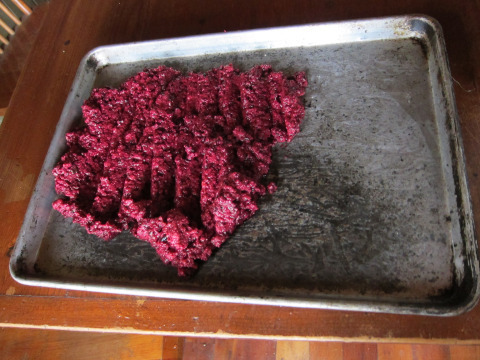
Chokecherry pulp
For fruit leather, we cook our applesauce ’til it gets real thick. You wanna get as much water out as possible without burning it. We spread it out on a dehydrator tray or cookie sheet about 1/2″ thick and put it in the oven at 150-degrees ’til it holds together. Then we take it off the tray and set it on the rack until any stickiness is gone, cuz stickiness = water = mold. Stores real good in plastic bags or glass jars.
Or keep peel on, core ‘em with one of these adding just enough water to blend, and dry as above. Sometimes, if we’re feeling rich and have nuts lying around, we’ll mix in a cup or so of homemade nut butter to make an apple-nut-butter-cracker sort of thing. Hell, yeah.
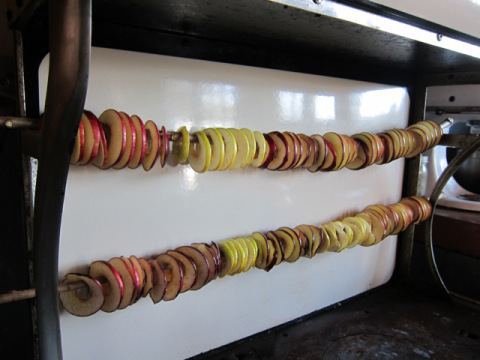
Drying on the cookstove
Finally, the path to dried apple ring enlightenment: Core as above, slice rounds 1/4″ thick, slide ‘em over sticks the boys brought home, and dry over the cookstove.
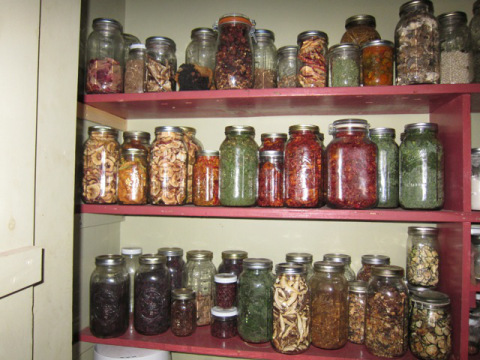
The winter pantry. Or a fraction of it, anyway: Apples, mushrooms, veggies, medicinals

October 30, 2013
Thank Me Later
We have been noshing inordinate quantities of this non-heading variety of broccoli we sourced from Fedco. It’s called piracicaba (peer-a-sea-cah-bah), and it’s sorta halfway betwixt a heading broccoli and a broccoli rabe, both of which are fine and all, but ain’t got nuthin’ on this baby. It’s wicked tender, a little sweet, and soaks up the butter like nobody’s business. It grows gobs of small side shoots that have been producing for months on end and which the boys are prone to plucking and eating raw on their way to raise some sort of hell or another. They’re also great steamed. The shoots, not the boys.
This bugger is so prolific we haven’t even been able to keep up with the 8 trial plants we seeded; a bunch of it went to flower and we were gonna lop those off to get more shoots growing, until Pen noticed all the pollinators hitting the flower bar. So we let ‘em go because bees are approximately the most important creature on this little farm.
Anyway. Piracicaba. Plant some in the spring, and thank me later.

October 29, 2013
It Is What They Do
The boys were up and out before first light to run their trapline, their headlamps bobbing and darting as they waddled down the field under the weight of their provisioned pack baskets. The baskets themselves are a product of their own hands, loaded with axes and traps and lure. Wire and water.
Trapping season opened on Saturday, and they spent the entire weekend (and I do mean every freakin’ hour of daylight) setting traps across our land and Melvin’s. On Sunday morning, I walked the line with them; it took better than two hours. When we got home, we ate breakfast, and the boys headed out again.
This weekend, up to our elbows in piggy bits, Penny and I got to talking about our sons’ learning experiences outside the formalized education system and how so many of those experiences have been enabled simply because they have the time to pursue them. This led to a quick calculation regarding how many hours they would have passed in school, were that to be their fate. For Fin, we tallied up 8400 hours; Rye, being approximately three years younger, would clock in at about half that. That’s before homework and before the 34 hours American children spend drooling in front of the television each week (Fin and Rye watch none). Add in the TV, and you’re talking – over just the past 6 years Fin would have been in school – upwards of 19,000 hours captive to either the classroom or the idiot box. Nineteen thousand. If you figure the boys are awake for about 14 hours each day, that’s 1,357 days or 3.7 years of my older sons’ waking life. The mind boggles.
How much of that time is truly productive, not merely in regards to learning and developing, but in terms of feeding emotion and spirit, in terms of fostering connection and a sense of a child’s place in this world? It’s a rhetorical question, because I don’t know the answer, and I don’t know that there really is an answer. How can you measure such things? I’m not exactly sure, but I strongly suspect pop quizzes, final exams, and mastery of pop culture trivia ain’t it.
After we got good and depressed dwelling on the math of modern childhood, a funk that only copious sampling of our latest batch of maple sausage could remedy (maple syrup, diced onion, garlic, salt, mustard powder and the piece de resistance, a generous splash of our friend Paul’s bathtub wine), we got to talking about what our boys have learned from trapping, all of their own passion and volition. Don’t get me wrong, much of what Fin and Rye learn is facilitated; There’s a pervasive notion that unschooling is about letting your children run wild and directionless, but of course nothing could be further from the truth (I won’t say much more about the subject of facilitated unschooling, because I don’t want to fritter fodder for a future post… crikey… awesomely abundant alliteration, already!). Our children do run wild, as every child should, but there’s a heck of a lot more to it than that.
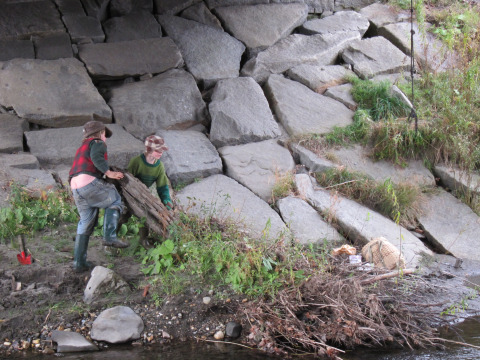
Mind the crack!
Anyhoo, here’s the list we came up with:
Money management: How many traps they need and can afford, how much to spend on books and lure, how much to save for future needs
Time management: Balancing chores and other responsibilities with running the trapline each morning
Earth Sciences: How the natural world surrounding them works
Biology: Understanding the relationship of animals, their habitat, season, etc
Anatomy: Yeah, I think they got this one nailed
Physical Education: Humping over hill and dale for hours on end, carrying 30-pound packs
Math: Mostly relating to money management, but also considerations of wildlife carrying capacity
Awareness of advertising/corporate messaging: We talk all the time about how the contemporary fur market is dominated by corporate interests selling furs to China, which are purchased by individuals who’ve bought into a fashion trend
Ethics: Using all parts of the animal (newsflash: deep fried ram balls are not all that tasty), giving thanks, not trapping more than they can actually use/consume, using traps designed to minimize pain
Teamwork/cooperation: They do all this together
Geography: Using maps to determine who owns the land they want to trap, understanding topo maps, etc
Reading and Writing: Letters to landowners seeking permission, books on technique, etc
Human Relations: Approaching landowners, and even knocking on doors to ask permission
Success, failure, perseverance: Obvious
As Penny pointed out, they’ve even had the opportunity to memorize useless information just to pass a test, given the oft-inane nature of the so-called “knowledge” one needs to pass the trapper ed certification class (“what clothes should you wear while trapping?”)
My point is not to brag on my boys. They are, like all humans, imperfect creatures, with gaps in knowledge and character that only time can fill (and none of us live long enough to fill them all). I merely wish to make a point I’ve tried to make many a time in this space: Children learn. They do not need to be told to learn, or taught to learn. They sure as hell don’t need to be forced to learn, because it is what they do.
We just need to let them.

October 28, 2013
It’s Right There

Side o’ bacon
Thank you for all the thoughtful comments pertaining to Friday’s post. The wheels are slowly beginning to turn. Stay tuned.
We’re on something of a food production bender, what with it being October and all. Last weekend, it was kimchi and the lambs we relocated to the freezer, plus a passel more of applesauce and dried kale and whatnot and so forth. This weekend was all about the swine.
We’re big on pig. For starters, they’re eminently likable animals that when managed properly can do a whole lot of good and important work. With only minimal effort on our part, we’ve turned and cleared numerous acres of pasture with our hogs, land that was recently forest but now grows sweet, lush grass our cowsies and sheepsies covert to copious quantities of milk and meat. Furthermore, pigs are what’re known as “easy keepers.” They’re an unfussy species, prone to contentment. I like animals that are prone to contentment, perhaps because they remind me of how I might best make my way in this world. Furthermore again, pigs are relatively easy to slaughter and process at home, eliminating the complication, inconvenience, and expense of transport and butcher fees. Further furthermore again, there is no tiring of sausage, at least ’round these parts. Finally furthermore, we have access to quantities of organic waste milk and colostrum, significantly reducing the primary expense associated with critters whose sole purpose for living can occasionally seem to be the snarfing of exorbitantly expensive grain products.

Brine bucket
We made 60-odd pounds of sausage yesterday, a process that actually began on Friday. In order to facilitate cutting, the carcass must cool for at least a dozen hours, because hot meat is just too soft and squishy to cut. So we killed on Friday afternoon and left the big fella hanging from the tractor bucket overnight to stiffen up a bit. On Saturday, we hauled him inside (if you ever want a good laugh, you ought stop by and watch me and Penny laboring to get a 150-pound side o’ pork through the front door), splayed him across the counter, and commenced to hacking. Chops – check. Bacon in brine – check. Loin roast – check. Shoulder and ham chunked for grinding – check. Leaf lard bubbling on the wood stove – check. Organs cleaned – check.
We’ve been doing pigs like this for the past decade or so; oh, we did pigs before that, but there came a point when it occurred to us that we might’s well just keep the whole process in-house, so to speak. Our friends Ralph and Cindy taught us how to kill and dress (by-the-by, my favorite chapter in my first book is by far the one on Ralph and Cindy), and we were off to the races. It would be difficult to overstate how anxious I was the first time I approached the pigpen with a loaded .22 in my hands. I could not imagine ever slaughtering a large animal with confidence. I still experience a particular heightening of awareness in the moments before I pull the trigger (or, as has been the case for the past half-dozen or so pigs, the moment Fin or Rye pulls the trigger), but it is no longer from lack of confidence. Rather, I think it is from the sense of responsibility I feel toward the creature whose life I am about to take. I understand why many people are not comfortable being so close to this responsibility; it forces one to face something in themselves. It compels intent and intent can be discomfiting. I think it might be easier to live without intent. Poorer, to be sure. But easier.

Pig and lamb hearts for the sausage
Over the intervening years, we’ve slowly invested in handful of used commercial-grade processing implements – a grinder, a slicer, and a sausage stuffer that was actually a gift from our buddy Pete. We still do our cutting with a handsaw and a cleaver, and as such, our chops and roasts can be a little, um, inconsistent. Which is to say, if you come for dinner and we serve pork chops that are an inch-and-a-half thick on one end and three-quarters-of-an-inch thick on the other, it’s not because we were drunk when we cut ‘em. Well, it’s not because Penny was drunk, anyway.
I can’t say I love killing and processing pigs. Frankly, it’s hard work, and it takes a lot of time. Between set-up, killing, dressing, and cleanup, Friday’s slaughter took us about two hours. Cutting and wrapping took maybe three hours. And yesterday, what with all the grinding and mixing and stuffing and tasting and wrapping and cleaning, we’re talking at least five hours.
But there are compensations, and they are not limited to the abundance of meat in our freezer or the bacons brining on our porch. Because while the boys scoured the woods for the entirety of the weekend (trapping season opened on Saturday, and they are in a state of high agitation), Penny and I cut and sliced and ground and wrapped. And as we did so, we chatted, our hands slick with fat. We talked about the kids, about work, about our farm, about us. We chuckled about the fact that our notion of a date had somehow evolved to this point: A dead pig in pieces before us, our sons deep in the forest, their pack baskets laden with the implements of their trade. “Hey, at least I’m a cheap date,” said Penny. Damn straight, and only one of the many reasons I love the woman.

Penny on the stuffer
As someone who is still perhaps best known for writing a book about the local food movement, I frequently hear from folks who want to “get closer to their food” or some version thereof. Good for them, I say, with all sincerity. But the truth is, I know something they don’t: It’s not their food they’re looking to get closer to. Rather, it’s that same slightly uneasy sense of responsibility and intent I feel in the moments before I pull the trigger. It’s that same sense of satisfaction Penny and I feel as we wield our respective blades against the yielding flesh of the hog laid out before us. It’s that same sense of togetherness and common purpose toward the fundamental necessity of feeding our family. It’s that same sense of gratitude and awe that a meaningful life really can be as fundamentally simple as all this. I said “simple,” not “easy.”
So, yeah, it’s not food these people are looking to get closer to. It’s themselves. And the beauty of it is, it’s there. It’s right there.

October 25, 2013
Questions
There were some kimchi/kimchee related questions in yesterday’s comments that I will address soon, Also, at some point in the not-too-distant future, I intend to post about soil amending in more detail, partly in response to vpfarming’s occasional queries about the process that has resulted in our absurdly abundant gardens.
The issue of specific questions on this blog dovetails with the steadily increasing volume of other correspondence I’m receiving in relation to this site, my written work, or just life in general. Let me say right off the bat that I love hearing from folks. I mean, really, who wouldn’t? You’d have to be even more of a curmudgeon than I to realize it’s at least a minor honor that people take the time to reach out, either because they’re engaged enough to ask questions, or simply because something you’ve said or written has struck them. Besides which, whilst it may seem as if my life is just one raucous social event after another (this is a joke, because of course it couldn’t possibly seem like that), the inherent truth of the path we’ve chosen is that it’s, well, quiet. My paying work is primarily a solitary affair, occasionally bordering on lonely, and while I am immensely grateful for the company of my family, friends, and neighbors during day-in-day out goings-on of this little farm, I am also a gregarious fellow who sometimes craves more human interaction than this drowsy hill is capable of providing.
This is all a long-winded way of saying that I am struggling a bit with how to navigate the realities of the increasing readership of this site and to what extent I should devote my energies to satisfying that readership. I have to date invested only modest amounts of time and energy into this blog, and primarily to serve no one’s purpose but my own. But as traffic increases (don’t get me wrong, it’s still a humble fraction of what Jenna or Katz or Amanda sees on a daily basis), I can’t help but consider its future. I am not quite so selfish as to not wonder if there might be ways I can make this space feel more inclusive, or simply useful. In other words, what purpose, really, should this site serve? Should I just ignore all the questions, because answering them takes time away from my paying work, or from the multitude of unfinished and unstarted tasks that await me? That’s hard for me to do, honestly. I like people. I enjoy sharing the knowledge and experience we are fortunate enough to have gleaned over the years, just as so many have so generously shared their knowledge and experience with us.
Complicating all this is the sticky reality of money. I try very hard to take my own advice and not allow money to master my emotions and spirit. Mostly, I think I’m pretty good at this. But I’m not so good that I can just will the stuff out of my life. That is not my reality, any more than it’s yours. I passionately believe that time and money should not be conflated, but I do not inhabit a society that shares this belief, and on some level, I must submit to the reality that the time I spend on this site, or answering questions via other mediums is time I can’t spend on the work that pays my family’s way in this world. We are not supported by a trust fund. I did not cash out of a job in finance or tech. There’s nothing wrong with those paths; they just aren’t mine. What you see on this site – the books I have written, the links to magazine articles I’ve penned, the conferences and schools I’ve been lucky enough to speak at – are it. They are what pay for all the things we need but cannot provide for ourselves: Property taxes and diesel fuel, tractor parts and toilet paper. Soil amendments and snow tires.
Enough, already, eh? I hope none of you take this to mean that I don’t want to hear your questions or thoughts, because that is emphatically not the case. Truth is I want to hear more of them, though I might not always be able to reply. As has become my habit, I am merely using this space as a white board to work out the small questions of my life. And as always, I appreciate your support.

Ben Hewitt's Blog
- Ben Hewitt's profile
- 37 followers


